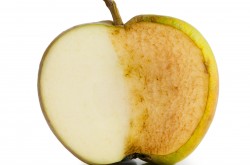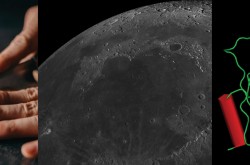3 things you should know about insects as an important source of protein, the science superpowers of soap, and monitoring glaciers in Canada’s Arctic

Meet Renée-Claude Goulet, Cassandra Marion, and Michelle Campbell Mekarski.
They are Ingenium’s science advisors, providing expert scientific advice on key subjects relating to the Canada Agriculture and Food Museum, the Canada Aviation and Space Museum, and the Canada Science and Technology Museum.
In this colourful monthly blog series, Ingenium’s science advisors offer up quirky nuggets related to their areas of expertise. For the August edition, they explain why insects are on their way to becoming an important source of protein in Canada, how and why soap actually works, and how the health and behaviour of Canada’s White Glacier is being monitored.

Humans consume insects at all life stages – egg, larva, pupa, and adult. Mealworms, seen here, are the larvae of a beetle.
Cricket burger with a side of fries, anyone?
To many, the thought of eating insects may seem out of the question. But, with comparable nutritional qualities to meat, and a fraction of the environmental impact, crickets and mealworms are on their way to becoming an important source of protein in Canada.
While unfamiliar to many Canadians, entomophagy – eating insects as food – is nothing new or strange. Ubiquitous and highly nutritious, insects have always been part of human diets, both as necessity and delicacy. Beetles, caterpillars, bees, ants, crickets, grasshoppers, and locusts are all popular choices. In fact, there are more than 2 000 species of insects eaten in about 140 countries across the globe!
And it's no surprise, really; insects are protein-packed and contain many vitamins and minerals we need, such as B12 and iron, and fatty acids like omega-3 and 6. Their exoskeleton – or outer shell – provides fibre, which goes on through our digestive tract to feed our gut bacteria. Most of the insect is edible, too, unlike other farmed animals. Though the great majority of insect species eaten worldwide are wild-harvested, according to the UN Food and Agriculture Organization, about two percent of them – namely mealworms and crickets – are farmed.
Crickets are incredible feed converters, requiring six times less feed than beef to produce a gram of protein. They also require minimal water, don't require agricultural land, can be produced locally, and have much lower greenhouse gas emissions than livestock farming. So, in essence, farming insects provides the nutrition of meat, but with an environmental impact closer to plants. This means eating crickets and mealworms could help meet the nutritional needs of more people while using fewer resources.
There are certain challenges to raising food-grade insects and so most production has remained small-scale. However, researchers and governments see an opportunity to diversify the agri-food sector and help alleviate pressure on our natural systems. Here in Canada, through its Agrinnovate program, Agriculture and Agri-Food Canada recently invested in a cricket-farming company called Aspire. Aspire is to build the world's largest high tech and automated cricket farm in London, Ontario. The operators will have the ability to continuously fine tune their techniques with the help of sensors, robotics, and data processing, and figure out the best way to raise and process crickets en masse.
Once the scalability code has been cracked, there are many uses envisioned beyond human food. In fact, because it may be a long time before people are ready to embrace insect protein as part of their diets, the first frontier is using cricket protein in pet food. With growing global demand for pet food, replacing livestock-derived protein with insect meal provides a sustainable way to reduce the environmental impact of Fido's food.
Though insects are not meant to replace other protein sources completely, they can act as a fourth option in our array of choices after animal products, legumes, and nuts and seeds. We already can find fried and seasoned crickets and cricket powder in our supermarkets. So, if you are feeling adventurous, there’s no need to wait until this food source is mainstream to try it!
By Renée-Claude Goulet

Even in the age of modern medicine, soap – with a recipe that remains mostly unchanged after 4000 years – remains one of our most important medical breakthroughs.
How and why does soap ACTUALLY work? The science superpowers of soap
Soap and water, wash and scrub, get those germs off rub-a-dub-dub.
The average household is filled with different kinds of soap. Soap for dishes, soap for clothes, soap for hands, soap for pets, and more! Soap has been around for at least 4000 years, and even though there are many different varieties, the basic science of how soap keeps us clean remains unchanged.
The science of soap is all in its molecular structure. Each molecule of soap is shaped a bit like a tadpole with a ‘head’ and a long ‘tail’. These two ends of the molecule have two very different behaviors. The head is attracted to water, while the tail shuns water and prefers to link up with fats and oils. These two opposing behaviors in the same molecule is what gives soap its superpowers.
Soap superpowers:
- Soap molecules grab dirt and grime. When you lather up, the fat-loving tails of the soap molecules grab onto the grease, oils, and dirt on your skin. When a whole bunch of soap molecules grab onto the same bit of grime with their tails, they surround and trap it within a floating sphere of soap molecules called a micelle.
- Soap allows water to carry away grease. When you rinse, the water-loving heads of the soap molecules follow the water, dragging their tails (still attached to dirt and grime) behind them. Without soap, the water alone would not get rid of the oils and grease on your hands since water and oil don’t mix.
- Soap is super effective against germs. We pick up A LOT of germs throughout the day. Once picked up, these microbes stick to the oils that your skin naturally produces and will hang around until they find a way inside your body (through your mouth, nose, eyes, or other). Soap effectively removes microbes from your hands by dislodging the oils they are stuck in, or by interacting with the microbes directly. The outer membranes of all cells, including bacteria, viruses, and fungi are made of fats. The fat-loving tails of the soap molecules grab onto these membranes, allowing the microbes to be lifted up and washed away. In some conditions, the soap molecules can actually pierce the cell membranes of microbes and tear them apart.
In the age of genetic engineering and robotic surgery, it is remarkable that a bit of soap and water is one of our most effective health interventions. So wet your hands, lather up, and scrub vigorously for at least 20 seconds. Don’t forget to scrub your wrists, the back of your hands, between the fingers, and around your nails. It is one of the most effective ways to prevent the spread of disease and infection (and to not be yucky).
Go further:
Which is more effective? Hand sanitizer or soap?
By Michelle Campbell Mekarski

Striking view of White Glacier looking north, on Axel Heiberg Island, NU, during an expedition in July 2022.
Six decades of glacier monitoring in Arctic Canada
Canada’s White Glacier is one of the best monitored glaciers in the world. Located on central Axel Heiberg Island, part of the Canadian Arctic Archipelago, the glacier measures approximately 14 km long with the end, called the terminus, some 7 km inland of Expedition Fiord.
I had the privilege of visiting White Glacier in July 2022 with glaciologist Dr. Laura Thomson, a professor at Queen’s University and acting manager of the McGill Arctic Research Station in summer 2022. The Station, a field research facility situated within view of the terminus, hosts a variety of researchers who study the High Arctic environment. It’s primary focus has been to facilitate the near continuous monitoring of White Glacier since 1960!
White Glacier is an alpine valley glacier that has receded about 1.5 km since 1960. It has melted and thinned so much that the tops of its lateral moraines – mounds of debris or till deposited by the glacier – that were once level with the height of the ice are now well above it.
The health and behaviour of the glacier is evaluated through annual measurements of mass balance – the sum of overall gain or accumulation of ice and snow, and ice loss through melting and calving. For example, every year, a series of pits are dug into the glacier to measure the thickness and density of the newest accumulated snow layers. Stakes are drilled deep into the ice and measurements of how much the stakes extrude from the surface later give an estimate of how much of the surface has melted. There are many other variables measured such as ice volume, flow velocity, internal temperature, as well as weather stations recording variables such as wind speed and air temperature.
Glacial monitoring has evolved from the 1960s to include both aerial surveys and remote sensing techniques from satellites orbiting the Earth. Thomson explains: “There are so many glaciers and too few glaciologists. We can’t measure them all on the ground.” Though ground measurements provide essential ground truthing information, satellite images and aerial surveys are great resources to monitor overall change through time. Changes in topography can be measured using radar (such as Canada’s RADARSAT Constellation Mission); volume changes can be estimated using stereo-optical imagery; tracking of features on the ice through time can be used to estimate glacier velocity; and ice elevation can be calculated from altimetry data.
In the case of the White Glacier, the mass losses outweigh the gains. Similar measurements are done on glaciers all over the world, and compiled by the World Glacier Monitoring Service in Zurich, Switzerland, to provide a global picture of glacier change and thereby climate change. As it turns out, Canada’s Arctic glaciers are not seeing as much loss as other parts of the world, as there are currently only about two months out of the year when temperatures rise consistently above zero. That said, Canada is still the third largest contributor to sea level rise behind Antarctica and Greenland because of the sheer number of glaciers in Canada. Axel Heiberg Island alone is home to more than 1000 glaciers.
By Cassandra Marion
Enjoying the Ingenium Channel? Help us improve your experience with a short survey!







































